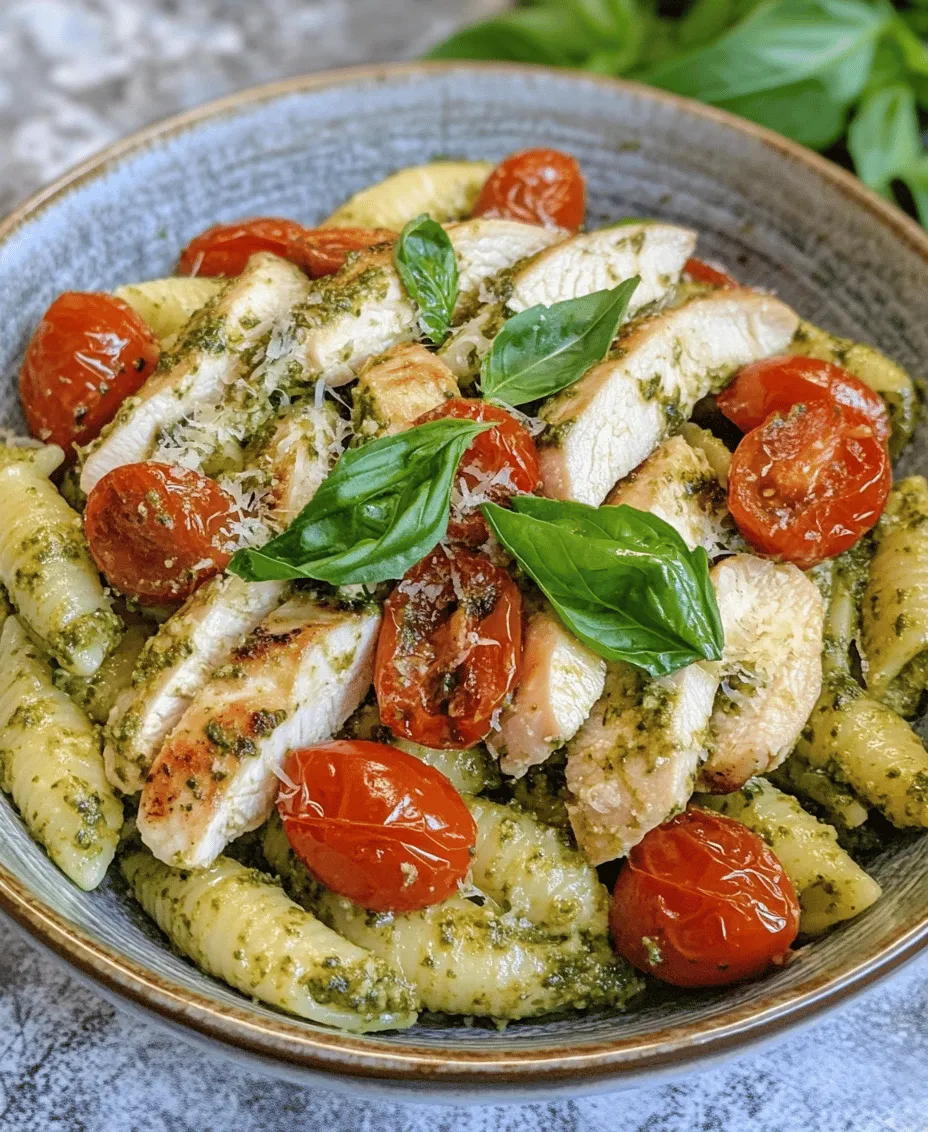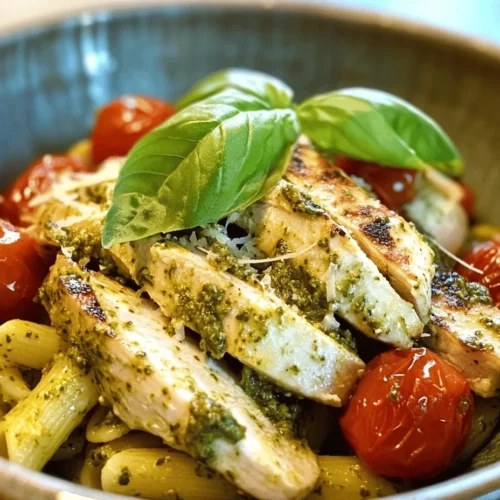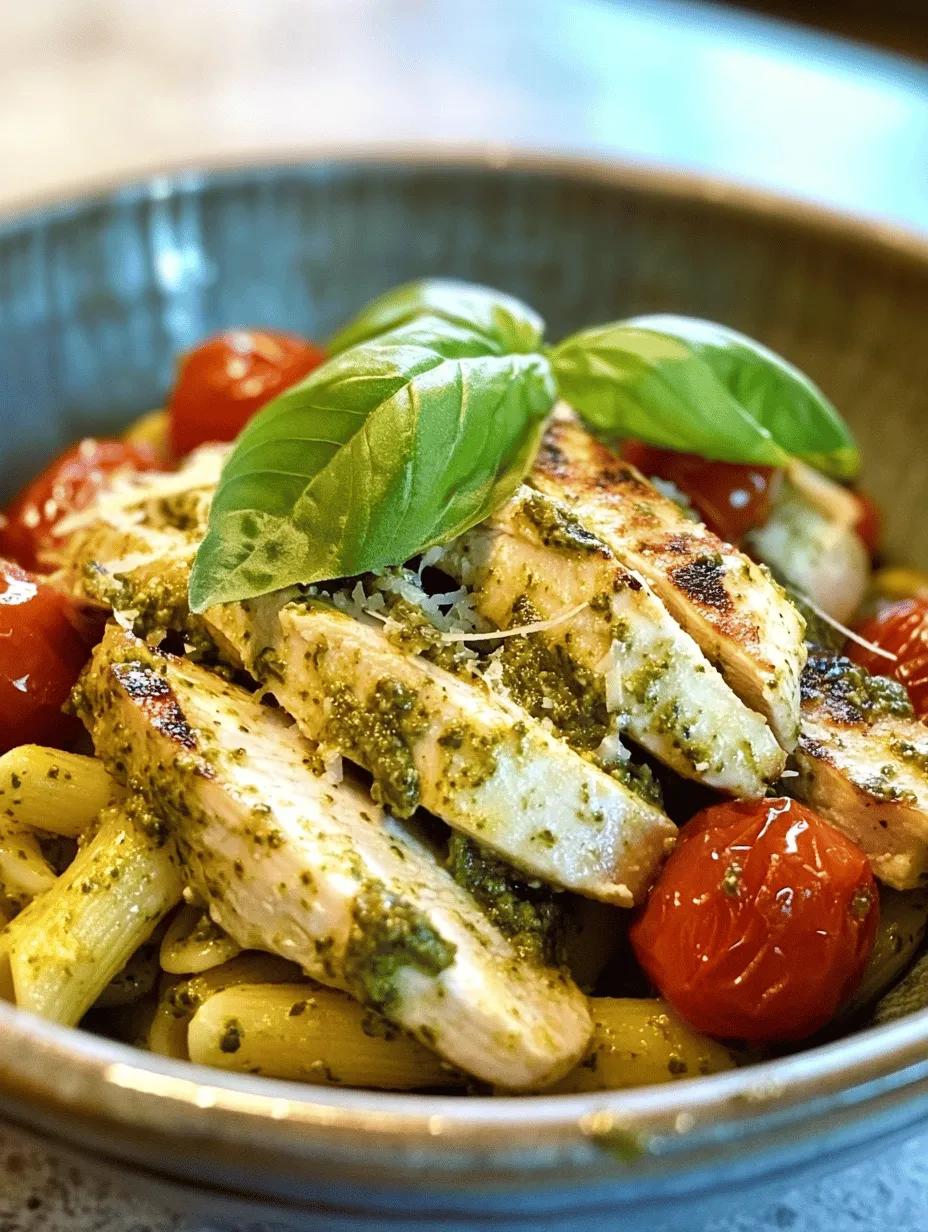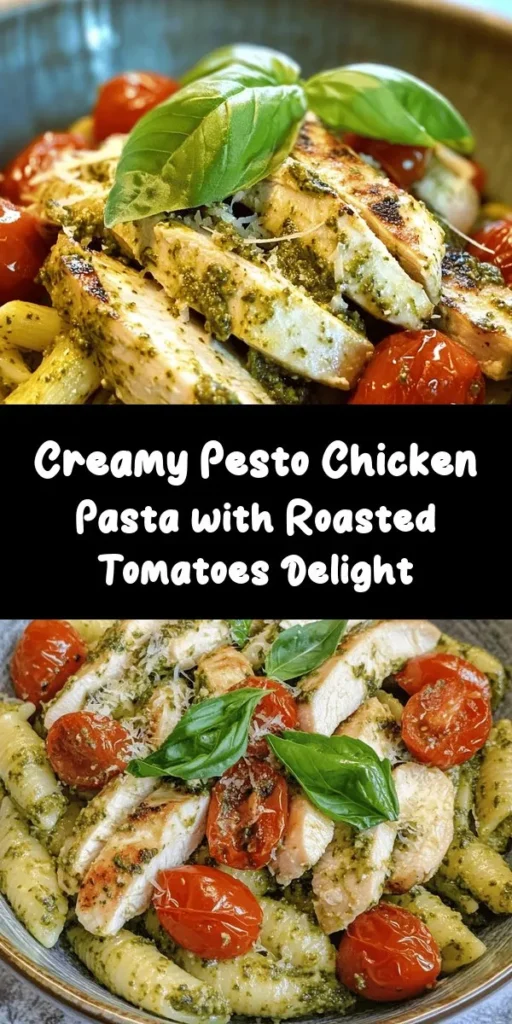Introduction
Are you on the lookout for a dish that perfectly combines rich flavors with a comforting touch? Look no further than creamy pesto chicken with roasted tomatoes. This delightful recipe isn’t just a feast for the taste buds; it also brings an inviting aroma to your kitchen and transforms a simple weeknight dinner into a gourmet experience. Whether you’re hosting a dinner party or just enjoying a meal with your family, this dish captures the essence of Italian cuisine while keeping it straightforward and accessible.
The appeal of creamy pesto chicken lies in its harmonious blend of flavors. The vibrant, herby notes of fresh basil pesto meld beautifully with the succulent chicken, while the roasted cherry tomatoes add a burst of sweetness that complements the richness of the sauce. Each bite is a comforting reminder of home-cooked goodness, making it a favorite for many. The use of fresh ingredients, particularly homemade elements, elevates this dish, ensuring that every flavor shines through.
In the following sections, we will dive into the key ingredients that make this dish a standout, explore the preparation techniques that enhance its flavors, and guide you through crafting the perfect creamy pesto sauce.
Understanding the Key Ingredients
Boneless, Skinless Chicken Breasts
At the heart of our creamy pesto chicken are boneless, skinless chicken breasts. This versatile protein is not only easy to cook but also packed with nutrients. Chicken breast is a lean source of protein, making it an excellent choice for health-conscious individuals. It contains essential vitamins and minerals, including B vitamins, which support energy metabolism and muscle function. The lack of skin reduces the overall fat content, allowing you to enjoy a rich dish without compromising your dietary goals.
When cooking chicken breasts, it’s essential to choose the right cooking method to ensure they remain juicy and tender. Overcooking can lead to dryness, so monitoring the cooking time is crucial. A simple sear in a hot pan followed by a gentle simmer in the creamy sauce is often the best approach for achieving that perfect balance of flavor and moisture.
Fresh Basil Pesto
What sets this dish apart is the vibrant flavor of fresh basil pesto. While store-bought versions can save time, nothing compares to the freshness of homemade pesto. Traditional basil pesto is made with a few simple ingredients: fresh basil leaves, garlic, pine nuts, Parmesan cheese, and olive oil. The result is a vibrant green sauce that’s bursting with flavor.
Homemade pesto allows you to control the ingredients, ensuring that you use high-quality produce and adjust the flavors to your liking. The fresh basil imparts a fragrant aroma that enhances the overall dish, while the nuts provide a delightful creaminess. When choosing between store-bought and homemade pesto, consider the freshness and flavor profile—homemade will always reign supreme for this recipe.
Heavy Cream
The creamy element of this dish comes from heavy cream, which serves as the base for the luscious sauce. Heavy cream is rich in fat, which is essential for achieving a velvety texture. When heated, it emulsifies beautifully with the pesto and other ingredients, creating a cohesive sauce that clings perfectly to the chicken and pasta.
In addition to its role in texture, heavy cream also rounds out the flavors, balancing the herbal notes of the pesto with a mild richness. It’s important to use high-quality heavy cream, as the flavor can significantly affect the overall dish. For those looking to lighten the recipe, alternatives like half-and-half or coconut cream can be used, but they may alter the final texture and taste.
Cherry Tomatoes
Adding a pop of color and flavor to our dish, cherry tomatoes are the perfect complement to creamy pesto chicken. These small, sweet tomatoes are not only delicious but packed with health benefits. They are rich in vitamins C and K, as well as antioxidants like lycopene, which has been linked to numerous health benefits, including heart health and cancer prevention.
Roasting cherry tomatoes brings out their natural sweetness while concentrating their flavor. As they cook, they caramelize, creating a rich, tangy contrast to the creamy sauce. The burst of sweetness from the roasted tomatoes enhances the overall experience of the dish, making it a true feast for the senses.
Grated Parmesan Cheese
No Italian dish is complete without cheese, and for this recipe, we’ll be using grated Parmesan cheese. The importance of quality cheese cannot be overstated; freshly grated Parmesan not only adds a depth of flavor but also enhances the creaminess of the sauce. Its nutty and savory notes complement the basil pesto, creating a harmonious blend of flavors.
When selecting Parmesan cheese, look for authentic Parmigiano-Reggiano. This cheese, which is produced in specific regions of Italy, has a distinct flavor and texture that elevates any dish. Grating your cheese just before use ensures maximum freshness and flavor, adding to the overall quality of your creamy pesto chicken.
Preparation Techniques
Roasting Tomatoes
Roasting tomatoes is a straightforward technique that enhances their natural flavors through caramelization. When exposed to heat, the sugars in the tomatoes break down, resulting in a concentrated sweetness and a tender texture that beautifully complements the creamy sauce.
To roast cherry tomatoes, simply toss them in a bit of olive oil, salt, and pepper, then spread them out on a baking sheet. Roast in a preheated oven until they are blistered and slightly caramelized, typically around 20 minutes at 400°F (200°C). This method not only intensifies their flavor but also adds a lovely visual appeal to your dish, as the vibrant red tomatoes contrast beautifully with the creamy sauce and green pesto.
Cooking Pasta
While the chicken and sauce are the stars of the show, the pasta serves as the perfect canvas to soak up all those delicious flavors. Cooking pasta to al dente perfection is key; this means the pasta should be cooked until it is firm to the bite. Overcooked pasta can become mushy and lose its ability to hold onto the sauce.
To achieve al dente pasta, bring a large pot of salted water to a rolling boil before adding your pasta. The salt enhances the flavor of the pasta itself, while the boiling water ensures even cooking. Follow the package instructions for cooking time, but start checking for doneness a minute or two before the suggested time to avoid overcooking. Once the pasta is done, reserve some pasta water before draining, as this starchy liquid can be used to adjust the consistency of your sauce later on.
Preparing Chicken
To ensure that your chicken breasts are flavorful and juicy, proper seasoning is essential. Start by patting the chicken dry with paper towels to remove excess moisture, which allows for better searing. Season both sides generously with salt, pepper, and any additional spices of your choice.
For a simple yet effective cooking method, heat a skillet over medium-high heat with a drizzle of olive oil. Sear the chicken breasts for about 5-7 minutes on each side until golden brown and cooked through. Depending on the thickness of the chicken, you may need to adjust the cooking time. A meat thermometer can be a helpful tool here; the internal temperature should reach 165°F (75°C) for safe consumption. Once cooked, let the chicken rest for a few minutes before slicing. This resting period allows the juices to redistribute, ensuring each bite is moist and flavorful.
Crafting the Creamy Pesto Sauce
Now that we have our key components ready, let’s dive into creating the creamy pesto sauce that ties this dish together. Start by combining your homemade or store-bought pesto with heavy cream in a saucepan over medium heat. The goal is to gently warm the mixture, allowing the flavors to meld without boiling.
As the sauce heats up, stir continuously to maintain a smooth texture. If it appears too thick, you can add a splash of the reserved pasta water to loosen it up. This starchy water not only helps achieve the desired consistency but also allows the sauce to adhere better to the pasta and chicken.
Once the sauce is warmed through, taste it for seasoning. Depending on the saltiness of your pesto and cheese, you may want to add a bit more salt or freshly cracked black pepper. Finally, fold in the freshly grated Parmesan cheese, stirring until it melts into the sauce and adds an extra layer of creaminess.
With all these elements combined, you’re ready to assemble your creamy pesto chicken with roasted tomatoes and pasta, creating a dish that’s sure to impress family and friends alike. The balance of flavors, textures, and colors in this dish makes it a standout, perfect for any occasion.
Stay tuned for the next part of this article, where we’ll delve into the final assembly, presentation, and serving suggestions to make your dining experience even more delightful.

Tips for Achieving the Perfect Creamy Texture
To achieve that velvety, creamy texture in your Creamy Pesto Chicken with Roasted Tomatoes, it’s crucial to follow a few essential tips. Start with a high-quality heavy cream or a blend of cream and milk to create a luscious sauce. Ensure you don’t let the sauce boil vigorously after adding the cream; instead, keep it on a gentle simmer to prevent curdling.
When incorporating the pesto, add it gradually while stirring continuously. This helps emulsify the sauce and ensures that every bite is packed with flavor. If you find the sauce too thick, you can thin it out with a bit of reserved pasta water—just a tablespoon at a time until you reach your desired consistency. This water, enriched with starch from the pasta, acts as a natural thickener and enhances the overall creaminess.
Combining the Elements
Timing is everything when it comes to combining your cooked pasta, chicken, and sauce. Once your pasta is al dente, drain it and immediately add it to the pan with the creamy pesto sauce. The warmth of the pasta will help it absorb the flavors and sauce, creating a cohesive dish.
After mixing the pasta with the sauce, fold in the cooked chicken gently to maintain the integrity of both the pasta and the chicken pieces. It’s essential to serve the dish right after combining everything to ensure that the creamy texture remains intact and the flavors are at their peak.
Visual presentation plays a significant role in enhancing the dining experience. Serve the creamy pesto chicken in a large, shallow bowl or plate, allowing the vibrant colors of the roasted tomatoes and fresh basil to stand out. A sprinkle of freshly grated Parmesan cheese over the top adds a beautiful finishing touch.
Garnishing with fresh basil not only adds a pop of color but also imparts an aromatic freshness that enhances the overall flavor profile of the dish. A light drizzle of extra virgin olive oil can elevate the dish further, adding a glossy finish that makes it even more inviting.
Serving Suggestions and Pairings
When it comes to side dishes that complement Creamy Pesto Chicken, consider options that balance the richness of the main course. A simple arugula salad with a lemon vinaigrette offers a peppery contrast, while steamed green beans or sautéed zucchini provide a fresh crunch. Garlic bread is also a fantastic accompaniment, perfect for soaking up any leftover sauce.
For beverage pairings, a chilled white wine, such as a Sauvignon Blanc or a light Chardonnay, works beautifully with the creamy flavors of the dish. If you prefer non-alcoholic options, a sparkling water with a splash of lemon or a herbal iced tea can cleanse the palate and enhance your meal experience.
For those with leftovers, this dish reheats well in the microwave or on the stovetop. If reheating in a pan, add a splash of cream or a bit of chicken broth to revive the sauce’s creaminess. Cover the pan to keep the moisture in, and stir occasionally to ensure even heating.
Nutritional Benefits
Creamy Pesto Chicken with Roasted Tomatoes is not only delicious but also offers a balanced nutritional profile. The dish contains a good amount of protein from the chicken, which is essential for muscle repair and growth. The heavy cream, while higher in calories, provides healthy fats that can help keep you satiated.
Carbohydrates from the pasta serve as a great source of energy, making this meal perfect for both busy weekdays and special occasions. To make the dish even healthier, consider using whole grain or legume-based pasta. These alternatives are higher in fiber and can help maintain stable energy levels.
If you’re looking to lighten the dish further, you can substitute the heavy cream with half-and-half or a plant-based cream alternative. Additionally, using less cheese or opting for a lower-fat version can help reduce the calorie count without sacrificing flavor.
Cultural Context and Variations
Pesto has its origins in Genoa, Italy, where it was traditionally made with fresh basil, garlic, pine nuts, Parmesan cheese, and olive oil. Over the years, it has evolved into various forms and adaptations, leading to the myriad of pesto recipes we see today. The versatility of pesto allows for countless variations, making it a beloved ingredient in many cuisines.
For those seeking vegetarian options, you can easily substitute the chicken with chickpeas, grilled vegetables, or even tofu for a plant-based protein source. If you’re looking for different pasta choices, consider zoodles (zucchini noodles) or gluten-free pasta to cater to dietary preferences.
Regional adaptations of the recipe may include variations in the type of nuts used in pesto; for example, walnuts or cashews can give a unique twist. The addition of sun-dried tomatoes can also offer a different flavor profile that pairs well with the cream and chicken.
Conclusion
Creamy Pesto Chicken with Roasted Tomatoes is a delightful dish that captivates the senses with its rich flavors and creamy textures. With each bite, the freshness of the basil and the sweetness of the roasted tomatoes create a comforting meal that is perfect for any occasion.
We encourage you to try this recipe, whether for a family dinner or a gathering with friends. The joy of cooking with fresh ingredients and sharing meals with loved ones is immeasurable. By incorporating simple yet vibrant flavors, this dish not only satisfies hunger but also nourishes the soul. Enjoy the process of creating this delicious meal and savor the delightful experience that comes with it.



